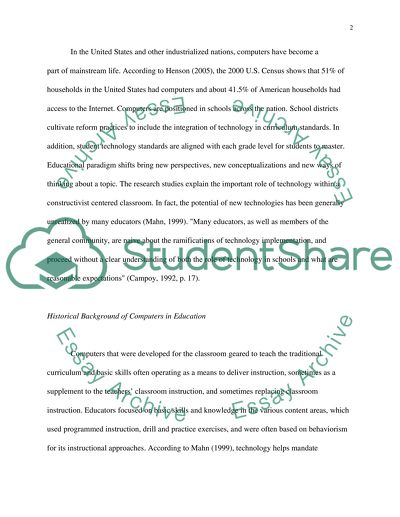Cite this document
(Knowledge Area Module as a Working Theory of Constructivism Essay Example | Topics and Well Written Essays - 1250 words, n.d.)
Knowledge Area Module as a Working Theory of Constructivism Essay Example | Topics and Well Written Essays - 1250 words. https://studentshare.org/education/1553338-paper-introductionthe-purpose-of-this-depth-section-of-the-kam-is-to-critically-examine-the-theories-supporting-technology-based-instructional-practices-aligned-with-the-current-educational-system
Knowledge Area Module as a Working Theory of Constructivism Essay Example | Topics and Well Written Essays - 1250 words. https://studentshare.org/education/1553338-paper-introductionthe-purpose-of-this-depth-section-of-the-kam-is-to-critically-examine-the-theories-supporting-technology-based-instructional-practices-aligned-with-the-current-educational-system
(Knowledge Area Module As a Working Theory of Constructivism Essay Example | Topics and Well Written Essays - 1250 Words)
Knowledge Area Module As a Working Theory of Constructivism Essay Example | Topics and Well Written Essays - 1250 Words. https://studentshare.org/education/1553338-paper-introductionthe-purpose-of-this-depth-section-of-the-kam-is-to-critically-examine-the-theories-supporting-technology-based-instructional-practices-aligned-with-the-current-educational-system.
Knowledge Area Module As a Working Theory of Constructivism Essay Example | Topics and Well Written Essays - 1250 Words. https://studentshare.org/education/1553338-paper-introductionthe-purpose-of-this-depth-section-of-the-kam-is-to-critically-examine-the-theories-supporting-technology-based-instructional-practices-aligned-with-the-current-educational-system.
“Knowledge Area Module As a Working Theory of Constructivism Essay Example | Topics and Well Written Essays - 1250 Words”. https://studentshare.org/education/1553338-paper-introductionthe-purpose-of-this-depth-section-of-the-kam-is-to-critically-examine-the-theories-supporting-technology-based-instructional-practices-aligned-with-the-current-educational-system.


